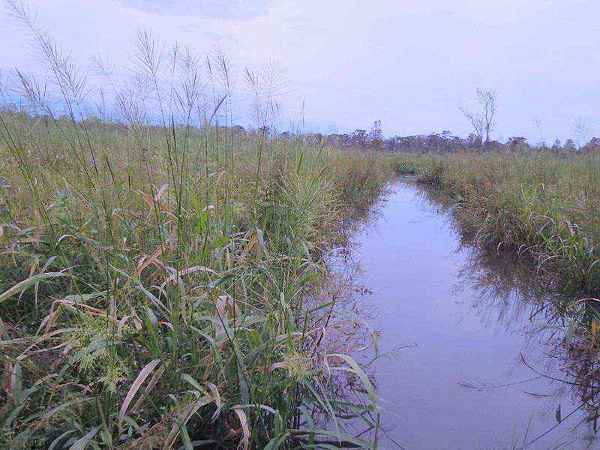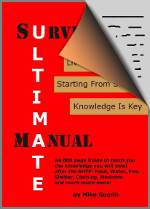Wild Rice Survival Food


Wild Rice for our purposes will include multiple species of rice that both grow in North America as well as abroad. In North America we will find Northern wild rice (Zizania palustris) which is an annual plant native to the Great Lakes region of North America, the aquatic areas of the Boreal Forest regions of Northern Ontario, Alberta, Saskatchewan and Manitoba in Canada and Minnesota, Wisconsin and Michigan in many other states of the USA. Wild rice (Z. aquatica), also an annual, grows in the Saint Lawrence River and on the Atlantic and Gulf coasts of the United States. Also there is another species called Texas wild rice. Their ranges when combined cover most of North America. Wild rice contrary to the name is not actually in the same family as commercially grown rice that we are all familiar with. Although their uses are identical.
As you can imagine you are not going to find wild rice growing anywhere within its range. Wild rice has certain requirements that must be met or it will not grow. First is sunlight. Wild rice will not grow in shade. This limits its availability tremendously. And as you can imagine it typically grows in a shallow water environment; slow flow not fast. When looking for this survival food think marsh! One great thing about this food source is once you have found it you often find it in great abundance.
Rice is harvested from late summer to early fall. The rice matures at different times on the same plant. So you can gently harvest today and then return in a week to harvest again. To harvest wild rice you paddle your boat into stands of the wild rice and gently bend the plants into the boat. You then gently tap the cluster and the seed falls into the boat. Move forward a couple of feet and repeat. Using this method you can quickly gather a lot of rice.
Once gathered Wild Rice must be processed before cooking and eating. After harvesting wild rice you must immediately dry it or you can alternatively leave it soaking in water for a couple of days until you can dry it. Spread out the gathered rice in a thin layer over a tarp or blanket or anything really that keeps it off of the ground. You do this to get rid of the moisture and is a must do before roasting. As the rice is drying, sort through it, removing any non-rice contaminants such as insect parts or leaf fragments etc.
Roasting the wild rice kernel is an important step in preserving this food for later use. To roast the rice you can do it like the Indians did and put the rice in woven mats above a fire or you can roast them in a pot while stirring constantly.
After roasting all the rice, the hull is removed. This will involve some work. Place some unhulled rice in a pot or bucket and then you basically stomp on the rice repeatedly to mechanically break down the hulls. Obviously you don't wear muddy shoes or bare feet when doing this. Your feet need to be wrapped in something strong and clean. Traditionally knee high moccasins were worn.
After getting your work-out stomping the rice to death, you need to separate the hull from the rice by winnowing. Winnowing is basically the separation of two different things by using their differences in density and weight to separate them. Throw a baseball into the air it falls back down. Throw a feather into the air and it floats off to the side because it is lighter and the wind moves it sideways before it reaches the ground. This process is what you will need to do to effectively remove the chaff (hulls) from the heavier rice. Toss the rice up and let the wind take the chaff away as the rice falls back into your winnowing basket or pan. Once this is done the rice is ready to be stored (or cooked) for later use.
The storage capability of wild rice is something that makes it one of the most awesome survival foods. Most food cannot be stored for long periods but not rice. Wild rice can be stored in airtight containers for years and still be edible. Try not to allow the stored rice to encounter very hot or freezing conditions and keep in a dark location.
WARNING:Wild Rice can be infected by toxic fungus. Infected grains have pink or purplish blotches. Do not eat this rice!!!
Tip:To harvest use two light sticks about 3 feet long. Use one to gently bend the plants into the boat and the other to very lightly tap the plant to dislodge the seed. If a lot of force is needed to remove the seed then you are too early. Wait for the seed to dislodge with only a light brushing, best performed with two people, one poling the boat slowly forward and the second collecting the seed.
As you can imagine you are not going to find wild rice growing anywhere within its range. Wild rice has certain requirements that must be met or it will not grow. First is sunlight. Wild rice will not grow in shade. This limits its availability tremendously. And as you can imagine it typically grows in a shallow water environment; slow flow not fast. When looking for this survival food think marsh! One great thing about this food source is once you have found it you often find it in great abundance.
Rice is harvested from late summer to early fall. The rice matures at different times on the same plant. So you can gently harvest today and then return in a week to harvest again. To harvest wild rice you paddle your boat into stands of the wild rice and gently bend the plants into the boat. You then gently tap the cluster and the seed falls into the boat. Move forward a couple of feet and repeat. Using this method you can quickly gather a lot of rice.
Once gathered Wild Rice must be processed before cooking and eating. After harvesting wild rice you must immediately dry it or you can alternatively leave it soaking in water for a couple of days until you can dry it. Spread out the gathered rice in a thin layer over a tarp or blanket or anything really that keeps it off of the ground. You do this to get rid of the moisture and is a must do before roasting. As the rice is drying, sort through it, removing any non-rice contaminants such as insect parts or leaf fragments etc.
After roasting all the rice, the hull is removed. This will involve some work. Place some unhulled rice in a pot or bucket and then you basically stomp on the rice repeatedly to mechanically break down the hulls. Obviously you don't wear muddy shoes or bare feet when doing this. Your feet need to be wrapped in something strong and clean. Traditionally knee high moccasins were worn.
After getting your work-out stomping the rice to death, you need to separate the hull from the rice by winnowing. Winnowing is basically the separation of two different things by using their differences in density and weight to separate them. Throw a baseball into the air it falls back down. Throw a feather into the air and it floats off to the side because it is lighter and the wind moves it sideways before it reaches the ground. This process is what you will need to do to effectively remove the chaff (hulls) from the heavier rice. Toss the rice up and let the wind take the chaff away as the rice falls back into your winnowing basket or pan. Once this is done the rice is ready to be stored (or cooked) for later use.
The storage capability of wild rice is something that makes it one of the most awesome survival foods. Most food cannot be stored for long periods but not rice. Wild rice can be stored in airtight containers for years and still be edible. Try not to allow the stored rice to encounter very hot or freezing conditions and keep in a dark location.
WARNING:Wild Rice can be infected by toxic fungus. Infected grains have pink or purplish blotches. Do not eat this rice!!!
Tip:To harvest use two light sticks about 3 feet long. Use one to gently bend the plants into the boat and the other to very lightly tap the plant to dislodge the seed. If a lot of force is needed to remove the seed then you are too early. Wait for the seed to dislodge with only a light brushing, best performed with two people, one poling the boat slowly forward and the second collecting the seed.


